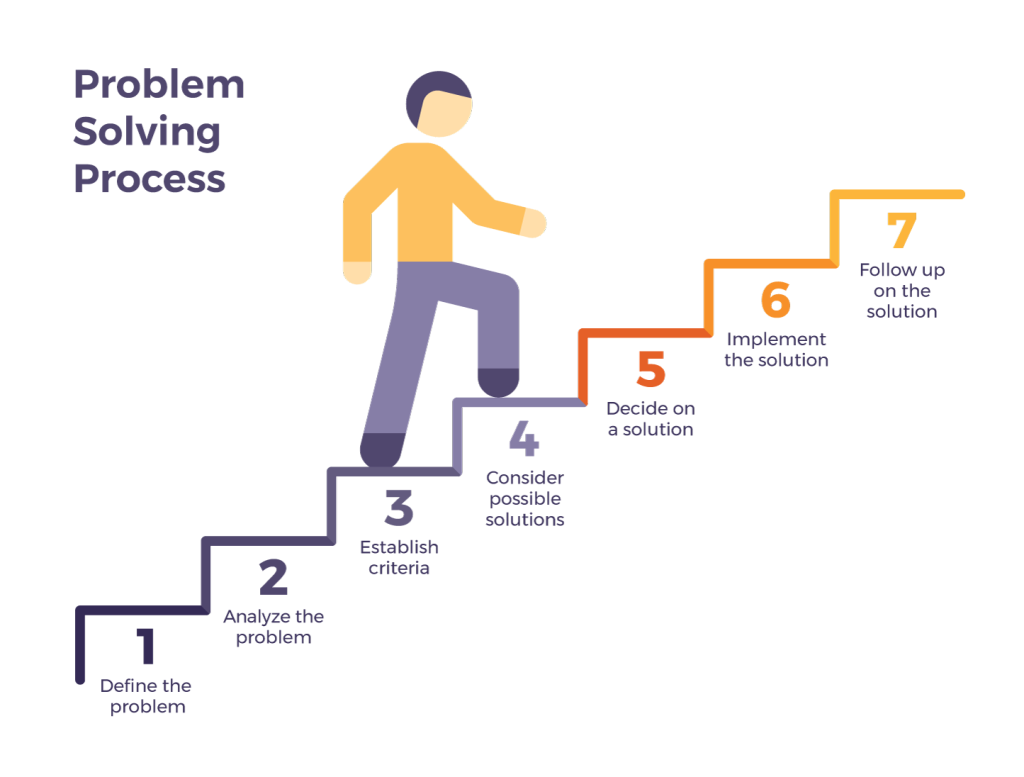21 Group Problem Solving – Part 1

Source: pixabay.com
The problem-solving process involves thoughts, discussions, actions, and decisions that occur from the first consideration of a problematic situation to the goal. The problems that groups face are varied, but some common problems include budgeting funds, raising funds, planning events, addressing customer or citizen complaints, creating or adapting products or services to fit needs, supporting members, and raising awareness about issues or causes.
While there are many ways to approach a problem, the American educational philosopher John Dewey’s reflective thinking sequence has stood the test of time. This seven-step process (Adler, 1996) has produced positive results and serves as a handy organizational structure. If you are member of a group that needs to solve a problem and don’t know where to start, consider the seven simple steps illustrated in Figure 11.2 below:

Figure 1. Problem-solving process.
Define the Problem
If you don’t know what the problem is, how do you know you can solve it? Defining the problem allows the group to set boundaries of what the problem is and what it is not and to begin to formalize a description or definition of the scope, size, or extent of the challenge the group will address. A problem that is too broadly defined can overwhelm the group. If the problem is too narrowly defined, important information will be missed or ignored.
In the following example, there is a web-based company called Favourites that needs to increase its customer base and ultimately sales. A problem-solving group has been formed, and they start by formulating a working definition of the problem.
Example problems:
Too broad: “Sales are off, our numbers are down, and we need more customers.”
More precise: “Sales have been slipping incrementally for six of the past nine months and are significantly lower than a seasonally adjusted comparison to last year. Overall, this loss represents a 4.5 percent reduction in sales from the same time last year. However, when we break it down by product category, sales of our nonedible products have seen a modest but steady increase, while sales of edibles account for the drop off and we need to halt the decline.”
Analyze the Problem
The problem-solving group Kevin, Mariah, and Suri analyze the problem and begin to gather information to learn more. The problem is complex and requires more than one area of expertise. Why do nonedible products continue selling well? What is it about the edibles that is turning customers off?
Kevin is responsible for customer resource management. He is involved with the customer from the point of initial contact through purchase and delivery. Most of the interface is automated in the form of an online “basket model,” where photographs and product descriptions are accompanied by “buy it” buttons. He is available during normal working business hours for live chat and voice chat if needed, and customers are invited to request additional information. Most Favourites customers do not access this service, but Kevin is kept quite busy, as he also handles returns and complaints. Because Kevin believes that superior service retains customers while attracting new ones, he is always interested in better ways to serve the customer. Looking at edibles and nonedibles, he will study the cycle of customer service and see if there are any common points—from the main webpage, through the catalog, to the purchase process, and to returns—at which customers abandon the sale. He has existing customer feedback loops with end-of-sale surveys, but most customers decline to take the survey and there is currently no incentive to participate.
Mariah is responsible for products and purchasing. She wants to offer the best products at the lowest price, and to offer new products that are unusual, rare, or exotic. She regularly adds new products to the Favourites catalog and culls underperformers. Right now she has the data on every product and its sales history, but it is a challenge to represent it. She will analyze current sales data and produce a report that specifically identifies how each product—edible and nonedible—is performing. She wants to highlight “winners” and “losers” but also recognizes that today’s “losers” may be the hit of tomorrow. It is hard to predict constantly changing tastes and preferences, but that is part of her job. It’s not all science, and it’s not all art. She has to have an eye for what will catch on tomorrow while continuing to provide what is hot today.
Suri is responsible for data management at Favourites. She gathers, analyzes, and presents information gathered from the supply chain, sales, and marketing. She works with vendors to make sure products are available when needed, makes sales predictions based on past sales history, and assesses the effectiveness of marketing campaigns.
The problem-solving group members already have certain information on hand. They know that customer retention is one contributing factor. Attracting new customers is a constant goal, but they are aware of the well-known principle that it takes more effort to attract new customers than to keep existing ones. Thus, it is important to ensure a quality customer service experience for existing customers and encourage them to refer friends. The group needs to determine how to promote this favourable customer behaviour.
Another contributing factor seems to be that customers often abandon the shopping cart before completing a purchase, especially when purchasing edibles. The group members need to learn more about why this is happening.

